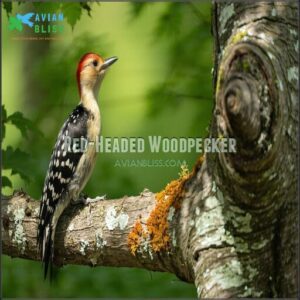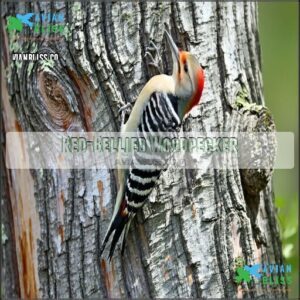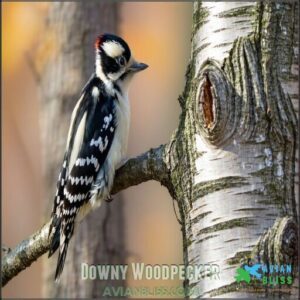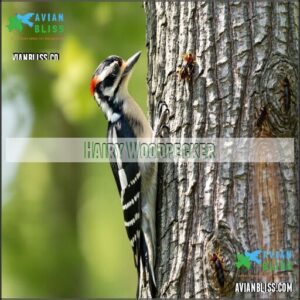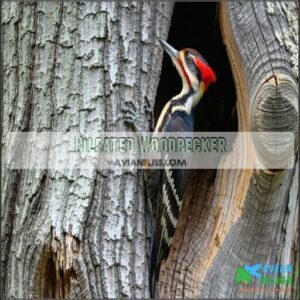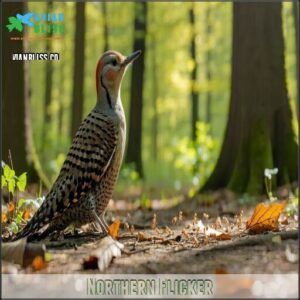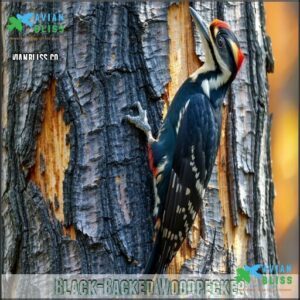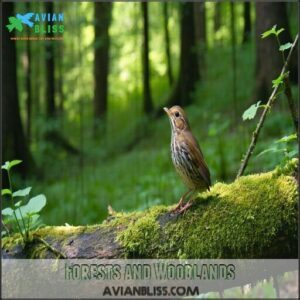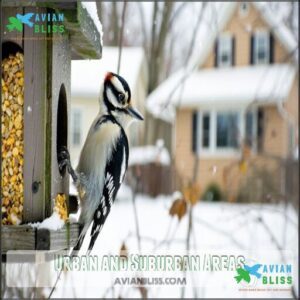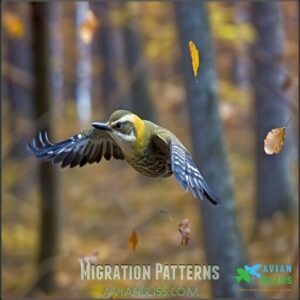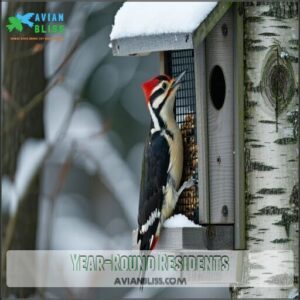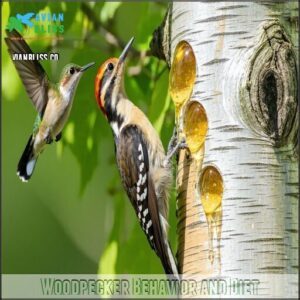This site is supported by our readers. We may earn a commission, at no cost to you, if you purchase through links.
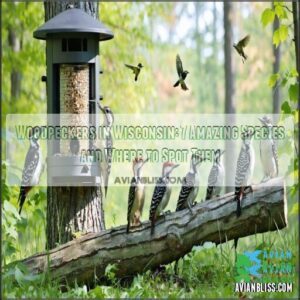
You’ll spot the striking Red-Headed Woodpecker in open woodlands, while the Red-Bellied Woodpecker prefers forests and backyards.
The tiny Downy and lookalike Hairy Woodpeckers are regulars at feeders, while the massive Pileated Woodpecker, with its loud calls, thrives in mature forests.
Northern Flickers often forage on the ground, and the elusive Black-Backed Woodpecker sticks to northern coniferous forests.
They drum for mates, snack on insects, and even sip sap.
Want more tips on attracting them or finding the best spots to watch? Wisconsin’s woodpeckers are worth the effort!
Table Of Contents
- Types of Woodpeckers in Wisconsin
- Woodpecker Habitat and Distribution in Wisconsin
- Woodpeckers in Wisconsin’s Backyard
- Woodpecker Behavior and Diet
- Why Do Woodpeckers Peck on Houses?
- Woodpecker Conservation Status in Wisconsin
- Woodpecker Watching Tips in Wisconsin
- Woodpeckers and The Law in Wisconsin
- Frequently Asked Questions (FAQs)
- What is the most common woodpecker in Wisconsin?
- Are woodpeckers good to have in your yard?
- What does it mean if a woodpecker is pecking my house?
- What will keep woodpeckers away from your house?
- What is the rarest woodpecker in Wisconsin?
- Do woodpeckers stay in Wisconsin in the winter?
- When are woodpecker migration patterns typically observed?
- How do woodpeckers impact local ecosystems in Wisconsin?
- Are there any festivals celebrating woodpeckers in Wisconsin?
- How can residents report rare woodpecker sightings in Wisconsin?
- Conclusion
Types of Woodpeckers in Wisconsin
You’ll find eight regularly observed woodpecker species in Wisconsin, from the tiny Downy Woodpecker to the impressive Pileated Woodpecker, each with distinct features to help you identify them in the field.
Wisconsin’s forests and backyards provide habitat for these remarkable birds, which you can recognize by their unique patterns of black, white, and splashes of red plumage.
Red-Headed Woodpecker
The Red-Headed Woodpecker (Melanerpes erythrocephalus) stands out among Wisconsin woodpeckers with its unmistakable crimson head, crisp black back, and snow-white belly.
With its bold crimson head and striking black-and-white plumage, the Red-Headed Woodpecker is a true gem of Wisconsin’s woodlands.
You’ll recognize this medium-sized bird by its striking plumage details—the only woodpecker in Wisconsin with a completely red head from crown to neck.
- Adults weigh 2.0-3.2 oz with a wingspan of 16.5 inches, while the juvenile stage shows grayish-brown heads instead of red.
Population trends indicate decline, making each sighting in Wisconsin’s open woodlands particularly special.
Red-Bellied Woodpecker
While its name suggests otherwise, the Red-bellied Woodpecker’s most striking feature is actually its bright red cap and nape.
You’ll recognize this medium-sized Wisconsin woodpecker by its distinctive black-and-white barred back and pale underparts with just a subtle rosy wash on the belly.
Listen for their rolling "churr-churr" vocalizations when exploring forests and woodlands.
Their range expansion has brought them increasingly into suburban areas, making them easier than ever to spot at backyard feeders.
Downy Woodpecker
While the Red-bellied Woodpecker may steal the spotlight, the Downy Woodpecker is Wisconsin’s tiniest woodpecker species.
At just 5.5-6.7 inches long and under an ounce in weight, these black-and-white birds are easily identified by their checkered pattern and males’ small red patch.
- They drum on trees with their disproportionately short bills
- Their "pik" calls echo through Wisconsin’s forests year-round
- They perform acrobatic feeding maneuvers on slender branches
- Their undulating flight pattern resembles a gentle wave
Hairy Woodpecker
The Hairy Woodpecker, often mistaken for its smaller Downy cousin, stands out in Wisconsin’s forests with its distinctive characteristics.
At 7.1-10.2 inches long with a 13-16.1 inch wingspan, this common woodpecker is noticeably larger than the Downy. You’ll recognize it by its longer, stronger bill and crisp black-and-white plumage.
Males sport a small red patch on the back of their head.
Listen for their sharp, loud "peek" calls and powerful drumming in mature woodlands.
Their diet consists primarily of wood-boring insects, though they’ll happily visit suet feeders in your backyard during winter months.
Pileated Woodpecker
While the Hairy Woodpecker brings its own charm to Wisconsin’s forests, the magnificent Pileated Woodpecker truly stands out as the giant among local species.
With its crow-sized body, striking Red Crest, and bold black-and-white pattern, this impressive bird is unmistakable in Wisconsin’s woodlands.
You’ll recognize its powerful Drumming Sound echoing through forests, where it creates substantial Nest Cavities in dead trees that later benefit many other forest creatures.
Its Habitat Needs include mature forests with large trees.
Northern Flicker
The Northern Flicker stands out as one of Wisconsin’s most distinctive woodpecker species.
Unlike its tree-dwelling relatives, you’ll often spot this unique bird foraging on the ground for its favorite meal—ants!
- Flicker Identification: Look for spotted breast, brown coloration, and either red (Eastern) or black (Western) "mustache" marks
- Flicker Habitat: Open woodlands, forest edges, and suburban areas throughout Wisconsin
- Flicker Diet: Primarily ants and beetles, supplemented with fruits and seeds
- Flicker Behavior: Often drums on metal surfaces during mating season
Black-Backed Woodpecker
While Northern Flickers prefer open woodlands, the Black-backed Woodpecker remains Wisconsin’s most elusive species.
The Black-backed Woodpecker, thriving in post-fire habitats, is Wisconsin’s rarest treasure, a true reward for patient birdwatchers.
This rare bird thrives in post-fire habitats, particularly in the Nicolet National Forest.
Males sport distinctive yellow crowns against jet-black plumage.
Conservation status concerns grow as burned forests diminish. Your best chance for Blackbacked Woodpecker sightings comes after forest fires when they feast on bark beetles in charred trees.
Wisconsin woodpecker enthusiasts consider spotting one a true achievement, and it is a significant event in the context of post-fire habitats.
Woodpecker Habitat and Distribution in Wisconsin
You’ll find Wisconsin’s rich mosaic of forests, woodlands, and even suburban areas serving as home to eight regularly observed woodpecker species, with two additional rare visitors in specific northern regions.
Whether you’re exploring the dense northern forests where Pileated Woodpeckers thrive or watching Red-bellied Woodpeckers in your backyard, these remarkable birds have adapted to various habitats across the state.
Forests and Woodlands
Wisconsin’s diverse forests and woodlands serve as prime real estate for woodpeckers.
Mature stands with varying forest composition provide ideal habitat connectivity, while deadwood plays a vital role in their survival.
You’ll find species like the Pileated Woodpecker thriving where tree health allows for cavity creation.
Wisconsin wildlife managers maintain these ecosystems through selective forest management practices, preserving snags and fallen logs.
Next time you’re hiking through Wisconsin’s woodlands, listen for the distinctive drumming that signals these remarkable birds.
Urban and Suburban Areas
You might be surprised at how well woodpeckers have adapted to Wisconsin’s urban and suburban landscapes.
These resilient birds have become common fixtures in developed areas, finding creative ways to thrive alongside humans.
Woodpecker urban adaptation involves:
- Habitat Flexibility: City woodpeckers utilize mature trees in parks, utility poles, and even building facades as substitutes for natural forest structures.
- Food Resourcefulness: Backyard woodpeckers readily visit suet feeders and bird baths, supplementing their natural insect diet.
- Breeding Adaptability: Common woodpeckers like Downy and Red-bellied species nest in suburban habitats where dead limbs remain on trees.
- Human Impact Management: Despite woodpecker damage concerns, these birds actually help control insect populations in residential areas.
For successful backyard birding, maintain dead snags (when safe) and install specialized feeders to observe these fascinating Wisconsin residents up close.
Migration Patterns
Five Wisconsin woodpecker species display fascinating migration patterns. The Yellow-bellied Sapsucker completely leaves the state during winter months, traveling to southern regions.
Red-headed Woodpeckers migrate irregularly depending on food availability, moving in loose flocks during daylight hours.
Climate influence and food sources determine these seasonal movements. Red-bellied Woodpeckers have expanded their year-round range northward in recent decades.
Understanding these woodpecker migration patterns helps you predict when and where you’ll spot these remarkable birds throughout Wisconsin.
Year-Round Residents
Unlike their migratory cousins, woodpeckers across Wisconsin remain steadfast residents year-round.
These hardy Wisconsin bird species have remarkable winter adaptations that help them thrive even during brutal snowstorms.
Common woodpeckers like the Downy, Hairy, and Red-bellied establish permanent territories they’ll defend through all seasons.
You’ll notice their breeding habits begin earlier than other birds, with drumming starting in late winter.
Food availability rarely becomes an issue as they’ve evolved to find insects beneath bark and readily visit suet feeders in your yard.
The Pileated Woodpecker, Wisconsin’s largest resident species, creates distinctive rectangular holes while searching for carpenter ants.
Their adaptation to local habitats makes these woodpeckers Wisconsin’s most reliable feathered neighbors.
Woodpeckers in Wisconsin’s Backyard
You’ll find Wisconsin’s eight common woodpecker species visiting backyards throughout the state when you provide the right food sources and habitat features.
With proper feeder selection and tree preservation, you can transform your outdoor space into a woodpecker haven where these fascinating birds will return regularly.
Attracting Woodpeckers With Feeders
Throughout the year, attracting woodpeckers to your Wisconsin backyard starts with strategic feeder placement. Position bird feeders within 10-15 feet of trees to provide safety and comfort for these cautious visitors.
- Suet feeders reign supreme for woodpecker attraction
- Upright feeder designs mimic natural feeding positions
- Placement matters—woodland edges offer ideal visibility
- Pest-proof feeders prevent squirrel competition
- Fresh suet recipes with peanut butter create irresistible appeal
Consider exploring different suet feeder options to find the best fit. Regularly clean feeders to maintain woodpecker health and loyalty, ensuring the best attraction methods are used for these birds, with a focus on natural feeding positions and irresistible appeal.
Seed Cylinders and Mealworms
Seed cylinders and mealworms offer powerful nutrition that Wisconsin woodpeckers can’t resist. Beyond standard suet, these specialized options provide complete meals in convenient packages.
- Cylinder composition matters: Look for blends with sunflower seeds, nuts, and dried fruits woodpeckers love
- Mealworm nutrition boosts protein intake, especially during nesting season
- Feeder placement at 10-15 feet high mimics natural foraging heights
In winter feeding, cylinders last longer than suet in our cold Wisconsin temperatures. Providing water sources such as bird baths attracts these birds, which is a critical aspect of their care and can be considered a key factor in attracting them.
Tree Selection for Woodpeckers
Wisconsin’s forest giants are key to attracting woodpeckers to your yard.
Select native trees with at least 40 cm diameter, particularly oaks, maples, hickories, and elms that provide cavity nesting opportunities.
Woodpeckers prefer trees with softer interior wood and rough bark where insects abound.
Leave decaying wood standing when safe—Pileated Woodpeckers favor deciduous trees with large diameters, while Red-headed Woodpeckers thrive among dead snags mixed with living oaks.
In Wisconsin woodlands, tree size directly impacts woodpecker habitat quality.
Consider the benefits of planting trees to support local woodpecker populations.
Creating a Woodpecker-Friendly Garden
Your garden can become a woodpecker paradise with thoughtful planning. Wisconsin woodpeckers are attracted to landscapes that mimic their natural habitats.
Here’s how to create your woodpecker haven:
- Native Trees: Plant oaks, maples, or birches that naturally support insect populations
- Insect Hotels: Install small structures that house beetles and grubs – woodpeckers’ favorite snacks
- Water Source: Add a simple bird bath or small fountain for drinking and bathing
- Nesting Boxes: Mount specialized houses with proper dimensions for different species
- Deadwood Benefits: Keep a snag or log pile as natural feeding stations
Don’t forget to install suet or sunflower seed bird feeders to supplement their diet year-round.
Woodpecker Behavior and Diet
You’ll discover Wisconsin’s woodpeckers have specialized feeding behaviors ranging from drilling for insects to drinking tree sap and enjoying fruits, nuts, and seeds.
Whether you’re watching a Downy Woodpecker extract larvae from tree bark or a Yellow-bellied Sapsucker creating sap wells, understanding their diet helps you identify and attract these fascinating birds to your yard.
Insectivorous Behavior
Woodpeckers in Wisconsin exhibit remarkable insect consumption techniques that define their role as forest janitors.
- Foraging techniques include drumming on dead trees to locate wood-boring insects
- Their specialized barbed tongues extend to extract larvae from deep tunnels
- Seasonal diet shifts focus on ants and beetles during summer months
- Wisconsin woodpeckers consume thousands of destructive insects daily, including emerald ash borer larvae
Their persistent pecking isn’t random—it’s precise hunting for hidden meals.
To prevent property damage, consider visual and noise deterrents.
Sap-Drinking Behavior
Among Wisconsin’s diverse woodpecker species, the Yellow-bellied Sapsucker stands out with its unique sap-drinking behavior.
These clever birds fastidiously drill horizontal rows of "sap wells" into tree bark, creating a natural fountain of nutrient-rich liquid.
Unlike other woodpeckers, sapsuckers return repeatedly to these wells, lapping up both the sugary sap and any insects attracted to it.
This specialized feeding technique provides essential nutrition throughout Wisconsin’s changing seasons, utilizing a method that is both efficient and specialized.
Fruits and Nuts in The Diet
Beyond insects and sap, Wisconsin woodpeckers have a surprisingly varied diet.
These feathered foragers actively seek fruits and nuts throughout the year, with seasonal availability affecting their preferences.
You’ll find Red-bellied Woodpeckers stuffing acorns into tree crevices, while Northern Flickers feast on wild cherries.
This foraging behavior doesn’t just satisfy hunger—their natural storage techniques help disperse seeds, contributing to forest regeneration across the state’s diverse habitats.
Suet and Sunflower Seeds
Suet and sunflower seeds are irresistible to woodpeckers in Wisconsin, providing the nutritional value they need for energy and survival, especially during colder months.
Explore various suet types and seed preferences using a sturdy woodpecker feeder. Pay attention to feeder placement for ideal viewing while keeping squirrels at bay with effective deterrents.
With the right setup, you’ll enjoy a lively show of Wisconsin’s woodpeckers right in your backyard.
Why Do Woodpeckers Peck on Houses?
You’ve probably wondered why those persistent woodpeckers are treating your home like a forest drum set.
When these Wisconsin birds peck on your house, they’re typically searching for insects in the wood, creating nesting cavities, or simply communicating with other woodpeckers through the resonant sound.
Drumming and Communication
When you hear rapid tapping on your house, you’re witnessing woodpeckers’ sophisticated communication system, not random noise.
This drumming serves specific purposes in Wisconsin woodpecker behavior.
- Territory defense: Bold, rapid patterns warn other woodpeckers to stay away
- Mating signals: Unique rhythms attract potential partners
- Sound variation: Each species has distinctive drumming patterns
- Interspecies communication: Different tempos convey specific messages
- Amplification: Hard surfaces like your gutters create louder, more effective signals
Nesting and Roosting
While drumming serves as communication, woodpeckers also peck on houses to create nesting cavities.
These birds excavate holes in siding or trim boards that mimic their natural nest site selection in dead trees.
Wisconsin woodpeckers are particular about roosting behavior, seeking secure locations for chick development. They’ll often choose softer wood materials for easier excavation.
If you notice precise, oval-shaped holes appearing on your home, you’re witnessing Wisconsin bird habitats in the making, which is a result of their natural instinct to create nesting cavities.
Insect Attraction
When woodpeckers target your home, they’re usually following their stomachs! These Wisconsin birds have an uncanny ability to detect insect prey hiding beneath your siding.
Woodboring insects, ants, and beetles create a natural buffet that’s hard for hungry woodpeckers to resist. Wisconsin woodpeckers use their specialized beaks to extract larval attraction points—places where wood-boring beetle larvae might be developing.
Their incredible hearing lets them pinpoint precisely where ant colonies or beetle consumption opportunities exist. To minimize damage, reduce insect populations around your house and create alternative feeding stations with suet feeders nearby.
Repairing Damages
Once insects have attracted woodpeckers to your home, repairing damages becomes essential.
Wisconsin homeowners often face costs exceeding $1,000 for siding repair after woodpecker attacks.
For effective hole filling, use wood putty on smaller holes and matching wood patches for larger damage.
Install deterrent methods like reflective tape or predator decoys for woodpecker prevention in suburban backyards.
In severe cases, professional help offers thorough woodpecker control solutions at reasonable costs.
Woodpecker Conservation Status in Wisconsin
You’ll find most Wisconsin woodpeckers classified as "Least Concern," though species like the Red-headed Woodpecker face challenges from habitat loss and climate change.
When you explore Wisconsin’s forests, you’re helping monitor these magnificent birds whose populations serve as indicators of overall forest ecosystem health.
Least Concern Species
Not all drumming on houses signals trouble—many of Wisconsin’s woodpeckers enjoy a solid Least Concern status thanks to thriving populations and abundant habitats.
Here’s why these species are flourishing:
- Population Trends: Downy woodpeckers easily adapt to forests and backyards.
- Habitat Security: Red-bellied woodpeckers thrive year-round, finding ample food and shelter.
- Conservation Actions: Protected cavity trees boost Pileated woodpecker numbers.
- Wisconsin Abundance: Nine species, from tiny Downy to massive Pileated woodpeckers, highlight strong biodiversity.
You’ll love spotting them!
Rare and Endangered Species
While most woodpeckers thrive in Wisconsin, several face serious population decline challenges.
The Red-headed Woodpecker has become a species of concern, while both the American Three-toed and Black-backed Woodpeckers are extremely rare finds.
| Species | Conservation Status | Best Viewing Location |
|---|---|---|
| Red-headed Woodpecker | Species of Concern | Summer: statewide |
| Black-backed Woodpecker | Extremely Rare | Nicolet National Forest |
| American Three-toed Woodpecker | Uncommon | Near Lake Superior (winter) |
Wisconsin bird conservation efforts focus on woodpecker habitat protection through specialized species recovery programs addressing these threats, which is a critical aspect of maintaining biodiversity and ensuring the well-being of these species, particularly those that are extremely rare.
Habitat Loss and Fragmentation
While endangered species face their own challenges, habitat loss presents an equally significant threat to Wisconsin’s woodpeckers.
As urban sprawl and agricultural expansion fragment once-continuous forests, these specialized birds struggle to maintain their populations.
Forest fragmentation impacts Wisconsin birds in four critical ways:
- Reduces available nesting trees for cavity-dwelling woodpeckers
- Isolates populations in woodland "islands," limiting genetic diversity
- Decreases food availability in smaller habitat patches
- Increases competition for remaining resources
Conservation strategies like reforestation efforts help reconnect these essential habitats, which is crucial for the survival of Wisconsin’s woodpeckers, and can help mitigate the effects of forest fragmentation and urban sprawl.
Climate Change Impacts
While habitat destruction remains concerning, climate change brings additional challenges to Wisconsin’s woodpeckers.
The impacts of climate change on woodpeckers can be summarized as follows:
| Climate Threat | Impact on Woodpeckers |
|---|---|
| Warmer winters | Earlier breeding seasons |
| Rising temperatures | Shifting food availability |
| Extreme weather | Uncertain lake levels |
| Forest changes | Loss of nesting sites |
| Habitat shifts | Species range alterations |
By 2100, the yellow-bellied sapsucker might disappear completely from Wisconsin, while the red-headed woodpecker could lose 94% of its habitat nationwide. The black-backed woodpecker, a "priority species" for conservation efforts, faces particular vulnerability to these changes.
These shifts can lead to earlier breeding times, impacting food availability. You’ll notice woodpeckers adapting their migration patterns and feeding behaviors as they respond to these environmental pressures.
Woodpecker Watching Tips in Wisconsin
You’ll find eight common woodpecker species across Wisconsin’s forests, parks, and even suburban neighborhoods if you know where and when to look.
With proper equipment and these practical tips, you’ll transform from a casual observer to a successful woodpecker spotter on your next outdoor adventure.
Best Times for Woodpecker Watching
While conservation efforts protect Wisconsin’s woodpeckers, knowing when to watch these fascinating birds can substantially improve your chances of spotting them.
Timing your birdwatching excursions strategically makes all the difference:
- Early mornings (dawn to 9 AM) offer peak woodpecker activity across Wisconsin
- Spring (March-May) brings dramatic courtship drumming and territorial displays
- Fall migration periods (September-October) showcase species movement patterns
- Winter months provide clearer viewing opportunities against leafless trees
Weather influences activity too—woodpeckers are more active on calm, sunny days.
Optimal Locations for Woodpecker Watching
To spot Wisconsin’s woodpeckers, head to these prime locations for unforgettable encounters:
| Location Type | Best Spots | Target Species |
|---|---|---|
| National Forests | Chequamegon-Nicolet | Pileated, Black-backed |
| State Parks | Devil’s Lake, Peninsula | Red-headed, Northern Flicker |
| Urban Hotspots | UW Arboretum, Milwaukee parks | Downy, Red-bellied |
Wisconsin forests and woodlands offer excellent birdwatching opportunities year-round.
You’ll find woodpeckers along trail edges in bird sanctuaries and even on private land with mature trees.
For a guaranteed sighting, Wisconsin birdwatching locations in northern counties often yield the best results.
Binoculars and Field Guides
Sharp eyes require proper tools for spotting Wisconsin’s woodpeckers. Select binoculars with 8×42 magnification for superior field viewing—they provide brightness and wide field of view for tracking birds in flight.
Modern field guide editions offer detailed illustrations of identifying markings like the Downy Woodpecker’s red head patch.
Consider portability considerations when choosing birdwatching binoculars; lightweight models prevent fatigue during long observation periods.
Supplement traditional birdwatching books with digital birdwatching apps that provide instant species verification at various birdwatching locations across Wisconsin. These specs provide superior field viewing.
Photography Tips
Capturing Wisconsin’s woodpecker wonders requires patience and proper camera techniques.
To get stunning woodpecker pictures, adjust your settings for these quick-moving birds:
- Use fast shutter speeds (1/1000s or higher) to freeze a Pileated Woodpecker’s powerful drumming action
- Select moderate apertures (f/5.6-f/8) for ideal depth of field while maintaining sharpness
- Position yourself with the sun at your back during early morning hours for ideal lighting techniques
Early mornings offer the best lighting for Wisconsin birdwatching photography, when birds are most active.
Remember ISO for balancing light sensitivity in varying conditions.
Bring a telephoto lens (300mm minimum) and a stable tripod for your equipment choices.
For composition tips, include some habitat context rather than just close-ups.
Remember that ethical photography means keeping a respectful distance.
Woodpeckers and The Law in Wisconsin
You’ll need to understand Wisconsin’s woodpecker protection laws before setting up backyard feeders or addressing home damage issues.
All woodpecker species in Wisconsin are protected under the Migratory Bird Treaty Act, making it illegal to harm, capture, or possess these birds without proper permits.
Protected Species
After observing those woodpeckers in their natural habitats, you’ll need to understand that all woodpecker species in Wisconsin are protected under federal law.
The Migratory Bird Treaty Act shields these birds from harm, making it illegal to hunt, capture, or disturb them without proper permits.
- The Black-backed Woodpecker’s rare status stirs deep appreciation when spotted
- Legal protections remind us of our responsibility to future generations
- Conservation programs create hope for struggling woodpecker populations
- Habitat protection efforts connect us to Wisconsin’s natural heritage
The importance of these protections cannot be overstated, as they are crucial for the long-term survival of these species.
Hunting and Trapping Regulations
Think woodpecker hunting in Wisconsin forests is an option? Think again! All woodpecker species are protected under state law, with no hunting seasons or trapping allowed.
These regulations safeguard Wisconsin woodlands and bird conservation efforts.
Aspect Details
Permit Requirements
Hunting Seasons
Protected Zones
Legal Methods
Bag Limits
Property Rights and Access
Respecting property rights is key when exploring Wisconsin forests and woodlands for woodpecker watching.
Always get permission before entering private lands, and follow public access restrictions on state-managed areas.
Landowners can address woodpecker damage liability through legal deterrents while maintaining nesting site control.
Conservation easement impacts may limit interventions, so check local regulations to balance birdwatching and property use responsibly.
Conservation Efforts and Organizations
Helping woodpeckers thrive in Wisconsin is easier than you think!
Conservation organizations like the Wisconsin Society for Ornithology and the Wisconsin Bird Conservation Partnership are leading bird conservation efforts through habitat preservation, population monitoring, and public education.
You can make a difference too!
Here’s how:
- Plant native trees or leave dead ones standing to support woodpecker habitats.
- Join citizen science projects to track woodpecker Wisconsin populations and contribute to essential data.
- Advocate for policy changes or donate to funding sources supporting woodpecker conservation and bird conservation organizations.
Every effort helps!
Frequently Asked Questions (FAQs)
What is the most common woodpecker in Wisconsin?
Imagine the Downy Woodpecker as the “friendly neighbor” of Wisconsin’s forests.
It’s the smallest, most common woodpecker you’ll spot, with black and white plumage and a cheerful knack for showing up just about everywhere.
Are woodpeckers good to have in your yard?
Yes, woodpeckers can be great for your yard!
They control insect populations by eating pests like beetles and ants.
Plus, their tree drilling creates nesting spots for other birds, boosting biodiversity in your backyard.
What does it mean if a woodpecker is pecking my house?
It’s no coincidence—woodpeckers peck houses seeking food, nesting spots, or to mark territory.
They’re likely after insects in wood or drumming to attract mates.
Check for damage, then consider deterrents like reflective tape or netting.
What will keep woodpeckers away from your house?
To keep woodpeckers away, hang shiny objects like aluminum foil strips or reflective tape.
Install bird netting, or use noisemakers.
Seal holes promptly, as woodpeckers might be searching for insects or establishing nesting spots.
What is the rarest woodpecker in Wisconsin?
The rarest woodpecker in Wisconsin is the Black-backed Woodpecker.
You’ll only spot this elusive bird occasionally in the Nicolet National Forest or northern woods, where it thrives in areas with fire-damaged trees.
Do woodpeckers stay in Wisconsin in the winter?
Winter woodpeckers withstand Wisconsin’s wicked weather, sticking around thanks to their thick plumage and steady food sources like insects, sap, and seeds.
You’ll often spot them tapping away, even when snow blankets the trees, which is made possible by their ability to find steady food sources.
When are woodpecker migration patterns typically observed?
Woodpecker migration patterns vary by species, but most don’t migrate far.
Some, like the Yellow-bellied Sapsucker, head south in fall, while others, like the Downy and Hairy Woodpeckers, stick around year-round.
How do woodpeckers impact local ecosystems in Wisconsin?
Woodpeckers shape ecosystems by controlling insect populations, creating nesting cavities for other species, and aiding forest regeneration.
Their drumming even aerates tree bark, fostering growth.
In Wisconsin, they’re nature’s multitaskers, balancing biodiversity with their unique habits, and through this, they play a crucial role in ecosystems.
Are there any festivals celebrating woodpeckers in Wisconsin?
While Wisconsin doesn’t host woodpecker-specific festivals, you can enjoy birding events like the Horicon Marsh Bird Festival or the Northwoods Bird and Wildlife Festival, which celebrate diverse bird species, including woodpeckers.
Bird enthusiasts might also consider attending a national bird festival for more opportunities to see diverse bird species.
How can residents report rare woodpecker sightings in Wisconsin?
You can report rare woodpecker sightings in Wisconsin through the Wisconsin Breeding Bird Atlas or eBird platforms.
These tools help track species distribution and conservation efforts—plus, your observation could contribute to scientific research!
Conclusion
Imagine Benjamin Franklin marveling at the intricate drumming of woodpeckers in Wisconsin.
These fascinating birds, from the striking Red-Headed to the elusive Black-Backed Woodpecker, thrive across diverse habitats, including forests, backyards, and urban areas.
By offering suet, mealworms, or native trees, you can attract these species to your garden and enjoy their unique behaviors.
Whether you’re watching them forage or listening to their rhythmic pecking, Wisconsin’s woodpeckers promise a rewarding experience for bird enthusiasts year-round.

